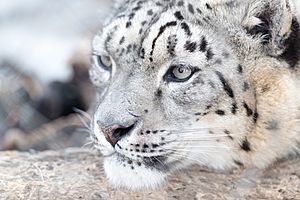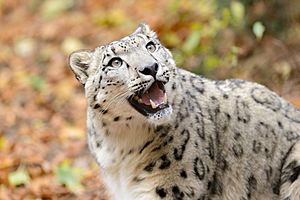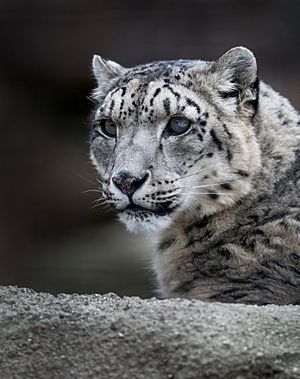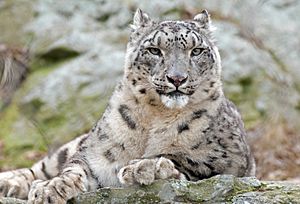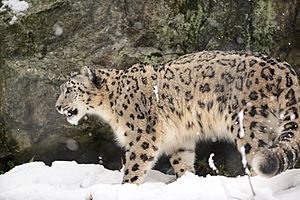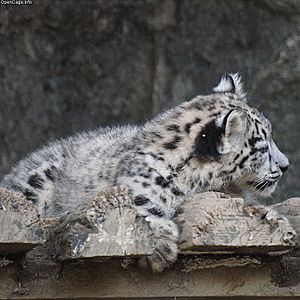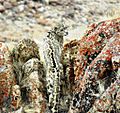Snow leopard facts for kids
Quick facts for kids Snow leopard |
|
|---|---|
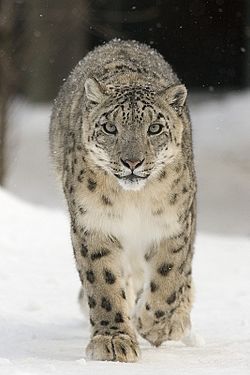 |
|
| Conservation status | |
| Scientific classification | |
| Kingdom: | |
| Class: | |
| Order: | |
| Family: | |
| Subfamily: | |
| Genus: | |
| Species: |
P. uncia
|
 |
|
| Range map | |
The snow leopard or ounce (Panthera uncia) is a large cat native to the mountain ranges of Central and South Asia.
It is listed as Vulnerable on the IUCN Red List of Threatened Species. As of 2016, the global population was estimated at 4,678 to 8,745 mature individuals.
Contents
Appearance
Snow leopards weigh between 22 and 55 kg (49 and 121 lb). They have grey and white fur with dark rosettes and spots, and their tails have stripes.
Its fur is very long and thick to protect it against the cold. Their feet are also big and furry, which helps them to walk on snow easier.
Their tails are 80 to 105 cm (31 to 41 in) long. They use their long tails for balance and as blankets to cover sensitive body parts against the severe mountain chill.
Behavior
The snow leopard is solitary, except for females with cubs. They rear them in dens in the mountains for extended periods. Male snow leopards require a territory of around 80 square miles, while females require up to 48 square miles of territory.
Like other cats, snow leopards use scent marks to indicate their territories and common travel routes. These are most commonly produced by scraping the ground with the hind feet before depositing urine or scat, but they also spray urine onto sheltered patches of rock.
Hunting
Snow leopards are solitary creatures and do not hunt in packs or groups.
Snow leopards are well camouflaged, and are most active at dawn and dusk. They stalk and eat medium-sized prey like Ibex, bharal (mountain sheep) and wild goats.
Snow leopards prefer to ambush prey from above, using broken terrain to conceal their approach. They kill with a bite to the neck, and may drag the prey to a safe location before feeding. Annual prey needs is 20–30 adult sheep (bharal).
Diet
Their main sources of food include wild sheep and goats, pikas, hares, and game birds. In the summer, they eat mostly smaller prey, such as marmots. At other times their prey includes wild boars, gazelles, markhor, bobak, tahr, ibex, bharal, mice, and deer. They stalk their prey and usually begin their attack when they are 20 to 50 feet (6-15 m) away.
The snow leopard's broad paws act as snow shoes and give them traction as they chase their prey across stone, snow, and icy surfaces. They are at their best when they can run across the hard, icy crusts that form above banks of deep snow while their prey breaks through the crust, getting mired in the soft, underlying snow.
Habitat
In summer, snow leopards usually live above the tree line on mountainous meadows and in rocky regions at altitudes from 2,700 to 6,000 m (8,900 to 19,700 ft). In winter, they come down into the forests to altitudes around 1,200 to 2,000 m (3,900 to 6,600 ft). Snow leopards prefer broken terrain, although they prefer to use existing trails made by other animals.
Snow leopards live in the high mountains of China and Central Asia, particularly throughout the Himalayas. They typically have a hunting range or territory of 100 square miles (260 square km), because very few prey animals live in the harsh, mountain habitat that is home to the snow leopard.
Reproduction
Snow leopards become mature at two to three years, and normally live for 15–18 years in the wild. In captivity they can live for up to 25 years. Cubs are born between April and June.
The mother gives birth in a rocky den or crevice lined with fur shed from her underside. Litter sizes vary from one to five cubs, but the average is 2. The cubs are blind and helpless at birth, although already with a thick coat of fur. Their eyes open at around seven days, and the cubs can walk at five weeks and are fully weaned by 10 weeks. Also when they are born, they have full black spots which turn into rosettes as they grow to adolescence.
The cubs leave the den when they are around two to four months of age, but remain with their mother until they become independent after around 18–22 months. Once independent, they disperse over considerable distances, even crossing wide expanses of flat terrain to seek out new hunting grounds.
Threats
Major threats to snow leopards include poaching and illegal trade of their skins. Greenhouse gas emissions will likely cause a shift of the treeline in the Himalayas and a shrinking of the alpine zone, which may reduce snow leopard habitat by an estimated 30%.
Where snow leopards prey on domestic livestock, they are subject to human–wildlife conflict. The loss of natural prey due to overgrazing by livestock, poaching, and defense of livestock are the major drivers for the ever decreasing snow leopard population.
Interesting facts about the snow leopard
- The snow leopard has the longest tail of any cat.
- It often hunts animals three times its size.
- Snow leopards can travel without difficulty in snow up to 85 cm (33 in) deep.
- They can survive on a single sheep for two weeks.
- In 2008, there were approximately 600 snow leopards in zoos around the world.
Conservation
The snow leopard is listed in CITES Appendix I. It has been listed as threatened with extinction in Schedule I of the Convention on the Conservation of Migratory Species of Wild Animals since 1985.
In India, the snow leopard is granted the highest level of protection under the Wildlife Protection Act, 1972, and hunting is sentenced with imprisonment of 3–7 years. In Nepal, it has been legally protected since 1973, with penalties of 5–15 years in prison and a fine for poaching and trading it.
In China, it has been protected by law since 1989; hunting and trading snow leopards or their body parts constitute a criminal offence that is punishable by the confiscation of property, a fine and a sentence of at least 10 years in prison.
Snow leopards inhabit the following protected areas:
- in Kazakhstan: Aksu-Zhabagly Nature Reserve
- in Russia: Katun Nature Reserve, Sayano-Shushenski Nature Reserve
- in Kyrgyzstan: Sarychat-Ertash State Nature Reserve, Sary-Chelek Nature Reserve, Besh-Tash State Nature National Park, Kyrgyz-Ata National Park, Karakol National Park, Chychkan Wildlife Refuge;
- in Uzbekistan: Chatkalskiy State Nature Reserve, Zaamin National Park, Ugam-Chatkal National Park, Hissar National Reserve;
- in Tajikistan: Pamir National Park
- in Mongolia: Altai Tavan Bogd National Park, Tsambagarav Uul National Park, Har Us Nuur National Park and Gobi Gurvansaikhan National Park
- in China: Chang Tang Nature Reserve, Qomolangma National Nature Preserve and Sanjiangyuan National Nature Reserve on the Tibetan Plateau, Tomur National Conservation Zone in the western Tianshan Mountains, Qilianshan National Nature Reserve in the Qilian Mountains,
- in Pakistan: Chitral National Park in the Khyber-Pakhtunkhwa region, Central Karakoram National Park and Khunjerab National Park in Gilgit-Baltistan, Deosai National Park, Naltar Wildlife Sanctuary, Baltistan Wildlife Sanctuary and several protected areas that are smaller than 300 km2 (120 sq mi);
- in India: Hemis National Park, Kishtwar National Park, Dachigam National Park, Gulmarg Wildlife Sanctuary, Hirpora Wildlife Sanctuary, Rangdum Wildlife Reserve, Overa-Aru, Kanji, Gya-Miru and Baltal-Thajwas Wildlife Sanctuaries in Ladakh, Jammu and Kashmir; Pin Valley National Park, Great Himalayan National Park, Rupi-Bhaba Wildlife Sanctuary, Sechu Tuan Nala Wildlife Sanctuary and Kibber Wildlife Sanctuary in Himachal Pradesh; Nanda Devi National Park, Gangotri National Park and Valley of Flowers National Park in Uttarakhand; Khangchendzonga National Park and Dibang Wildlife Sanctuary in the Eastern Himalayas;
- in Nepal: Api Nampa Conservation Area, Dhorpatan Hunting Reserve, Shey Phoksundo National Park, Annapurna Conservation Area, Manaslu Conservation Area, Langtang National Park, Sagarmatha National Park, Makalu Barun National Park and Kanchenjunga Conservation Area;
- in Bhutan: Bumdeling Wildlife Sanctuary, Jigme Dorji National Park and Wangchuck Centennial National Park.
At the end of 2020, 35 cameras were installed on the outskirts of Almaty, Kazakhstan in hopes to catch footage of snow leopards. In November 2021, it was announced by the Russian World Wildlife Fund (WWF) that snow leopards were spotted 65 times on these cameras in the Trans-Ili Alatau mountains since the cameras were installed.
| Country | Year | Estimate |
|---|---|---|
| Afghanistan | 2016 | 50–200 |
| Bhutan | 2016 | 79–112 |
| China | 2016 | 4,500 |
| India | 2016 | 516–524 |
| Kazakhstan | 2016 | 100–120 |
| Kyrgyzstan | 2016 | 300–400 |
| Mongolia | 2016 | 1,000 |
| Nepal | 2016 | 301–400 |
| Pakistan | 2016 | 250-420 |
| Russia | 2016 | 70–90 |
| Tajikistan | 2016 | 250–280 |
| Uzbekistan | 2016 | 30–120 |
Images for kids
-
Snow leopard at Hemis National Park, India
-
Snow leopard with Himalayan marmot, Kyrgyzstan
-
Snow leopard cubs at the Cat Survival Trust, Welwyn, UK
See also
 In Spanish: Leopardo de las nieves para niños
In Spanish: Leopardo de las nieves para niños



